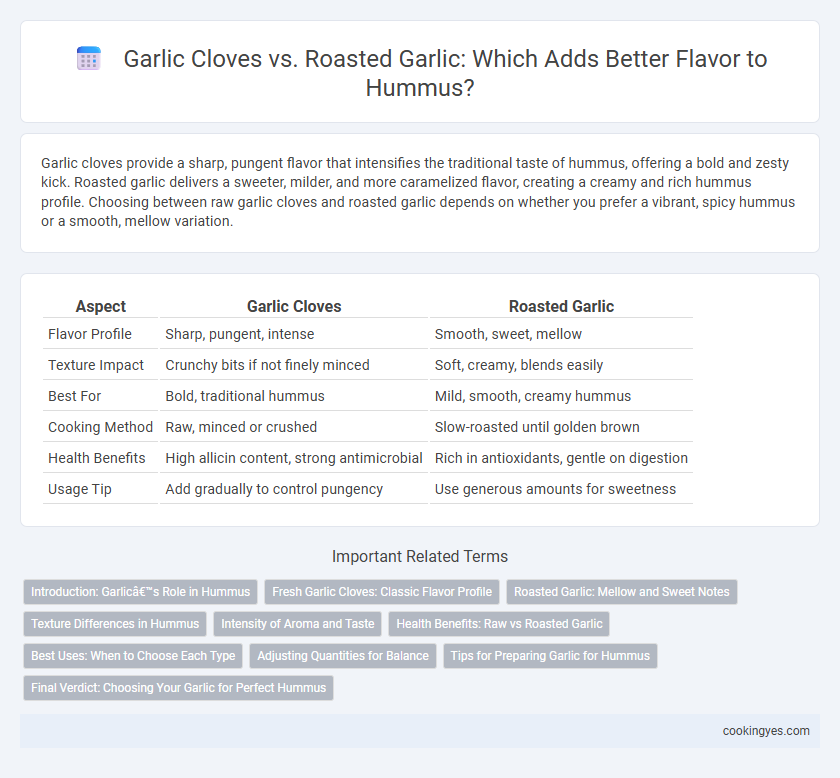Garlic cloves provide a sharp, pungent flavor that intensifies the traditional taste of hummus, offering a bold and zesty kick. Roasted garlic delivers a sweeter, milder, and more caramelized flavor, creating a creamy and rich hummus profile. Choosing between raw garlic cloves and roasted garlic depends on whether you prefer a vibrant, spicy hummus or a smooth, mellow variation.
Table of Comparison
| Aspect | Garlic Cloves | Roasted Garlic |
|---|---|---|
| Flavor Profile | Sharp, pungent, intense | Smooth, sweet, mellow |
| Texture Impact | Crunchy bits if not finely minced | Soft, creamy, blends easily |
| Best For | Bold, traditional hummus | Mild, smooth, creamy hummus |
| Cooking Method | Raw, minced or crushed | Slow-roasted until golden brown |
| Health Benefits | High allicin content, strong antimicrobial | Rich in antioxidants, gentle on digestion |
| Usage Tip | Add gradually to control pungency | Use generous amounts for sweetness |
Introduction: Garlic’s Role in Hummus
Garlic cloves provide a sharp, pungent flavor that intensifies hummus with a fresh, zesty kick, essential for authentic Middle Eastern taste. Roasted garlic offers a milder, sweeter, and caramelized flavor, creating a creamy, rich depth that softens the hummus' overall profile. Choosing between fresh and roasted garlic directly shapes the hummus flavor profile, balancing between vibrant bite and mellow creaminess.
Fresh Garlic Cloves: Classic Flavor Profile
Fresh garlic cloves provide a sharp, pungent flavor that enhances the traditional taste of hummus, delivering a bold and zesty punch. Their raw intensity blends seamlessly with chickpeas, tahini, lemon juice, and olive oil to create the classic hummus flavor profile. Using fresh garlic ensures a vibrant, aromatic lift that defines authentic Middle Eastern hummus.
Roasted Garlic: Mellow and Sweet Notes
Roasted garlic brings a mellow, sweet flavor to hummus, enhancing its creamy texture without overpowering the chickpeas' natural taste. The slow roasting process caramelizes the garlic sugars, resulting in a subtle, nutty aroma that balances the tahini and lemon juice perfectly. Using roasted garlic in hummus offers a richer, more complex flavor profile compared to the sharp bite of raw garlic cloves.
Texture Differences in Hummus
Garlic cloves provide a sharp, pungent flavor and maintain a slightly grainy texture in hummus, contributing to a more robust and zesty bite. Roasted garlic delivers a softer, sweeter taste that blends smoothly into hummus, resulting in a creamier, velvety texture. The choice between raw and roasted garlic significantly affects hummus mouthfeel, with roasted garlic enhancing spreadability and raw garlic adding textural contrast.
Intensity of Aroma and Taste
Fresh garlic cloves provide a sharp, pungent aroma and a bold, spicy taste that sharply enhances the hummus's flavor profile. Roasted garlic offers a milder, sweeter, and caramelized aroma with a smooth, earthy taste that creates a subtle, mellow hummus experience. The choice between raw and roasted garlic directly influences the intensity and complexity of hummus seasoning.
Health Benefits: Raw vs Roasted Garlic
Raw garlic cloves in hummus provide higher allicin content, a compound known for its potent antimicrobial and cardiovascular benefits. Roasted garlic offers a milder flavor with reduced allicin but contains increased antioxidants due to the Maillard reaction. Choosing between raw and roasted garlic balances stronger health benefits with gentler taste and digestive ease.
Best Uses: When to Choose Each Type
Raw garlic cloves deliver a sharp, pungent flavor ideal for hummus when a bold, spicy kick is desired, especially in traditional or quick recipes. Roasted garlic imparts a mellow, sweet, and caramelized taste perfect for creamy hummus variations that benefit from a smooth, rich depth and subtle garlic notes. Choosing raw garlic works best for fresh, vibrant dishes, while roasted garlic enhances recipes aiming for a softer, more nuanced flavor profile.
Adjusting Quantities for Balance
Using raw garlic cloves in hummus provides a sharp, pungent flavor that can quickly overpower the dish, so it's essential to start with small amounts, typically half a clove per cup of chickpeas. Roasted garlic offers a sweeter, mellow taste, allowing for larger quantities, often one to two bulbs, to achieve a rich, balanced flavor. Adjusting the garlic type and quantity helps maintain harmony between the garlic's intensity and the creamy texture of hummus for optimal taste.
Tips for Preparing Garlic for Hummus
Using fresh garlic cloves in hummus provides a sharp, pungent flavor that intensifies the dip, while roasted garlic offers a milder, sweeter taste with creamy texture. To optimize flavor, finely mince fresh garlic and let it sit for 10 minutes to develop its allicin content before blending. Roasting whole cloves at 400degF for 20-30 minutes caramelizes the sugars, creating a smoother, less overpowering garlic profile suited for a creamy hummus base.
Final Verdict: Choosing Your Garlic for Perfect Hummus
Fresh garlic cloves provide a sharp, pungent flavor that brightens hummus with a vibrant kick, ideal for those seeking a bold garlic taste. Roasted garlic offers a sweeter, mellow profile that adds depth and a creamy texture, enhancing the hummus's richness and smoothness. Selecting garlic depends on flavor preference--opt for raw garlic to emphasize brightness or roasted garlic to achieve a subtle, caramelized complexity in your perfect hummus.
Garlic Cloves vs Roasted Garlic for Hummus Flavor Infographic

 cookingyes.com
cookingyes.com